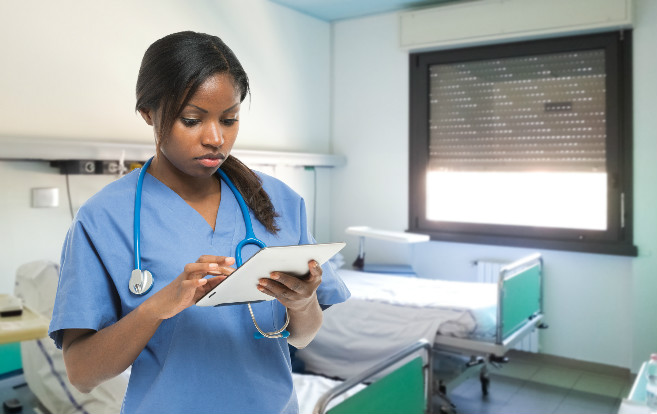How 'Most Wired' Hospitals Help Nurses and Patients

By Debra Wood, RN, contributor
The 2015 Most Wired hospitals are continuously “ratcheting up” their use of technology to streamline documentation, improve efficiency and drive clinical improvement, creating an elite group of facilities where nurses want to practice.
“Nurses should be proud to work at a Most Wired healthcare system, because it provides safety mechanisms, quality of care monitoring, communication tools and a technology infrastructure that supports them to take better care of their patients,” said Monica Puga, RN, ARNP, director of clinical informatics at Memorial Healthcare System in Hollywood, Fla.
At a Most Wired hospital, nurses “have a lot of things at their fingertips,” said Deanna Clawson, RN, a clinical analyst at Martin Health System in Stuart, Fla. “They can see the patient’s history in a concise way, see labs as soon as they are ready.”
That leads to more time to take care of patients and provide safer care, added Karen Anderson, RN, MSN, MBA, chief nurse executive for Loyola University Health System in Chicago.
Healthcare’s Most Wired
This year, 338 organizations, down 10 percent from 2014, received the Most Wired designation from H&HN magazine, a publication of the American Hospital Association (AHA). The AHA’s Health Forum and the College of Healthcare Information Management Executives released the results of the 17th annual HealthCare’s Most Wired Survey.
The survey sets specific requirements to receive the Most Wired designation in four focus areas: (1) infrastructure; (2) business and administrative management; (3) clinical quality and safety; and (4) clinical integration. This year, Most Wired facilities were required to meet a number of additional requirements, mainly related to meaningful use Stage 2, such as computer provider order entry, clinical decision support and assistive technology for medication administration.
Memorial Healthcare provides travel nurses with the same classroom-based, formal training on electronic systems as full-time staff, so they are fully up to speed on using tools such as clinical decision support to better care for patients. The system also provides credentialed trainers who round on the units and can be called for assistance.
“If you have a travel nurse who needs help with documentation, they can pick up the phone, and the trainer will go to the area and help her,” Puga explained. “Onsite personnel is nice, especially for the new nurse, because they get face-to-face time after training.”
Raising the bar
By Most Wired setting the bar higher, the designation creates a stretch goal for organizations to maintain the distinction. But that’s not the prime reason these hospitals stay ahead of the pack.
“From a nursing perspective, we continue to look at new technology to ensure we are optimizing workflow and efficiency,” Anderson said.
Loyola has implemented a Vocera call system that sends alerts directly to the nurse and reduces overhead paging. The health system is now implementing an app that will speed communication between providers and automatically place the notes or orders in the medical record. Nurse managers carry iPads while rounding on patients, so they can communicate immediately with ancillary departments.
As hospitals and health systems transition from volume-based care to more integrated, value-based care delivery, hospitals are utilizing information technology to better facilitate information exchange across the care settings. In 84 percent of Most Wired organizations, physicians can view and exchange other facilities’ results in the portal, compared with 63 percent of hospitals surveyed.
When Memorial began transitioning to an electronic environment in 2009, it opted for interoperability, so systems speak to one another. It also developed a health information exchange, connecting with physicians in the community to improve the continuum of care.
“The patient has one medical record, and the information is readily available to [nurses],” Pugh said. “It’s more efficient and the data is more reliable. You have access to physician notes, in relatively real time.”
Patient engagement
All of the Most Wired hospitals offer a patient portal, and 89 percent of them offer access through a mobile application. Typically, patients using portals can access their lab and radiology reports; review medication lists, discharge summaries and teaching materials; schedule appointments; and request prescriptions. The Memorial system also communicates with patients’ FitBits.
“It’s our best tool to provide patient engagement,” Puga said. “The portal is not just about checking results, but it’s a safety feature.”
Sixty percent of the Most Wired hospitals, including Martin Health and Loyola, offer patient-specific education in multiple languages. Memorial Healthcare’s patient education comes in the seven languages patients in the South Florida facilities commonly speak.
“We have more technology coming,” said Clawson. “This is the tip of the iceberg for things that are going to happen.”
© 2015. AMN Healthcare, Inc. All Rights Reserved.